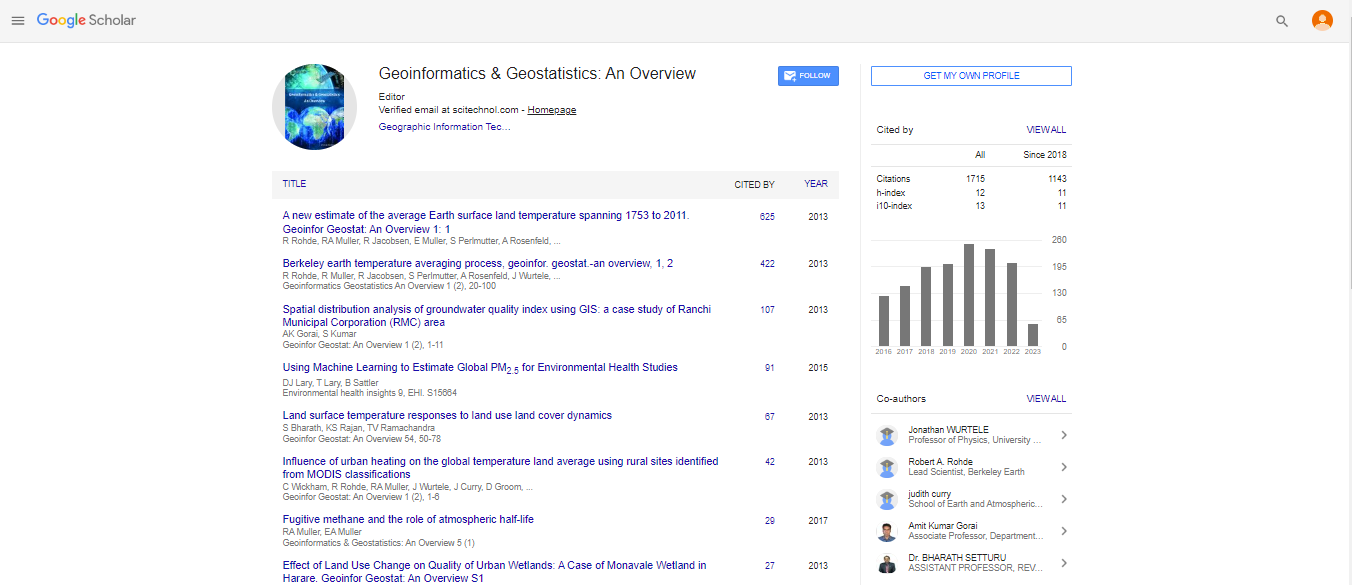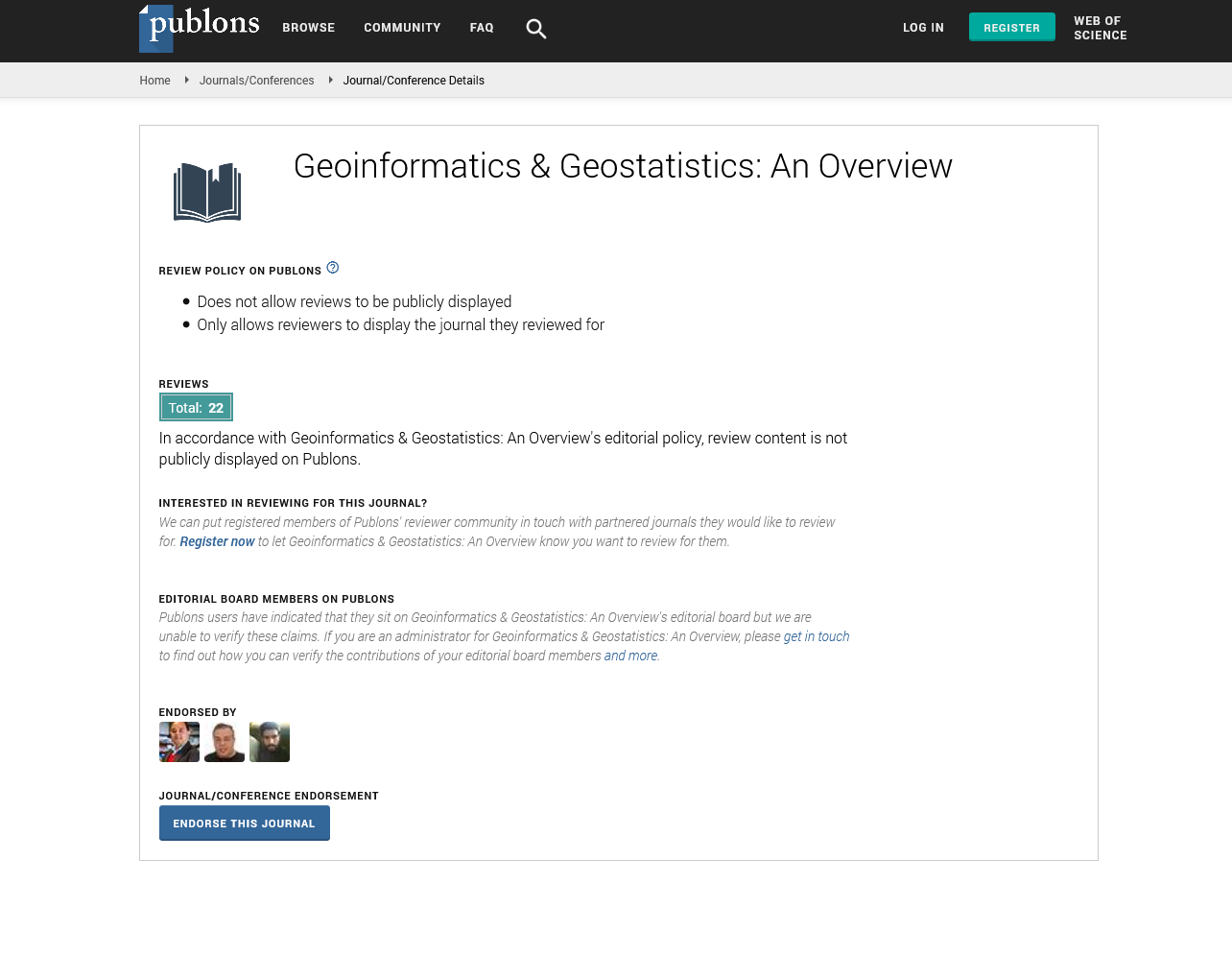Perspective, Geoinfor Geostat An Overview Vol: 12 Issue: 6
3D Geospatial Mapping: Revolutionizing the Study of Earth's Terrain and Features
Tina Brockhausen*
1Department of Regional Development, University of Castilla-La Mancha, Albacete, Spain
*Corresponding Author: Tina Brockhausen,
Department of Regional Development,
University of Castilla-La Mancha, Albacete, Spain
E-mail: T.bhausen@uclm.es
Received date: 25 November, 2024, Manuscript No. GIGS-24-156232;
Editor assigned date: 27 November, 2024, PreQC No. GIGS-24-156232 (PQ);
Reviewed date: 11 December, 2024, QC No. GIGS-24-156232;
Revised date: 18 December, 2024, Manuscript No. GIGS-24-156232 (R);
Published date: 26 December, 2024, DOI: 10.4172/2327-4581.1000427.
Citation: Brockhausen T (2024) 3D Geospatial Mapping: Revolutionizing the Study of Earth's Terrain and Features. Geoinfor Geostat: An Overview 12:6.
Description
The advancement of geospatial technologies has enabled the creation of three-dimensional (3D) maps that offer new perspectives and insights into geographic landscapes. 3D mapping involves the process of capturing and representing the Earth's surface in three dimensions, integrating height, width depth into a visual format. This technology has transformed numerous industries, particularly geography, by providing more accurate, detailed interactive models of the environment. This manuscript discusses the significance of 3D mapping in geography, its methods, applications future trends.
Significance of 3D mapping in geography
Traditional 2D maps have long been the standard in geographic representation, but they fall short when it comes to portraying the complexity of the Earth's surface. 3D mapping allows for the visualization of terrain in a more realistic and intuitive way, capturing features such as elevation changes, natural formations built structures. The integration of elevation data with Geographic Information Systems (GIS) provides geographers with an enhanced tool for spatial analysis. By visualizing geographic features in three dimensions, it is easier to interpret patterns, understand relationships predict outcomes in environmental studies, urban planning disaster management.
Methods of 3D mapping
Several techniques are employed in the creation of 3D maps, each offering distinct advantages based on the specific requirements of the project.
LiDAR (Light Detection and Ranging): This method uses laser light to scan the Earth's surface and measure distances accurately. LiDAR data is collected from aircraft, drones, or ground-based systems and provides detailed elevation models. It is particularly effective in mapping vegetation, urban areas large-scale landforms.
Photogrammetry: This technique involves using multiple photographs taken from different angles to generate a 3D model of a geographic area. Aerial and satellite imagery are often utilized, with sophisticated software algorithms stitching the images together to create a threedimensional representation. Photogrammetry is widely used in mapping terrain, buildings other structures.
Satellite and remote sensing: Modern satellites equipped with radar or optical sensors collect data that can be used for 3D mapping. Remote sensing offers a cost-effective way to capture large-scale geographical data, making it valuable for monitoring global changes such as deforestation, urban sprawl climate change.
Ground-based surveys: While less commonly used for large-scale mapping, ground-based surveys using GPS technology can be employed to gather precise 3D coordinates of specific features. This method is often used for small-scale projects or to supplement aerial and satellite data.
The practical applications of 3D mapping in geography are vast, spanning multiple fields and industries. Some of the most notable applications include:
Urban planning and development: 3D maps are invaluable tools for urban planners and architects. They help in visualizing infrastructure, assessing the impact of new constructions on the environment planning transportation networks. 3D models can also be used to simulate how urban areas will evolve over time.
Environmental monitoring and management: By representing topography, vegetation, water bodies other environmental features in 3D, geographic professionals can monitor changes to ecosystems, track deforestation evaluate the effects of climate change. 3D mapping is important for assessing the health of natural environments and managing resources effectively.
Disaster risk management: Natural disasters such as floods, landslides earthquakes often cause significant damage to communities and ecosystems. 3D maps can be used to model risk scenarios, helping to identify vulnerable areas and plan for emergency responses. They are also valuable for post-disaster assessments, aiding in recovery and rebuilding efforts.
Agriculture and land use: 3D mapping helps in precision agriculture by providing farmers with detailed terrain information, soil composition crop health data. This enables more efficient use of land and resources, increasing yields and reducing environmental impact.
Conclusion
3D mapping is revolutionizing the field of geography by offering more accurate, detailed interactive representations of the Earth's surface. With applications ranging from urban planning to environmental monitoring and disaster management, the potential for 3D mapping to transform geographic studies is immense. As technology continues to evolve, we can expect 3D mapping to become an even more integral tool in understanding and managing the world around us.
 Spanish
Spanish  Chinese
Chinese  Russian
Russian  German
German  French
French  Japanese
Japanese  Portuguese
Portuguese  Hindi
Hindi 
